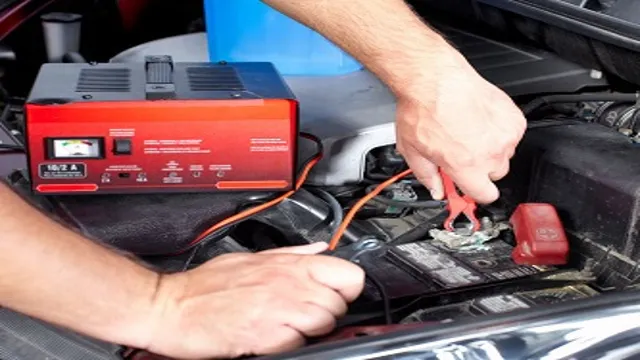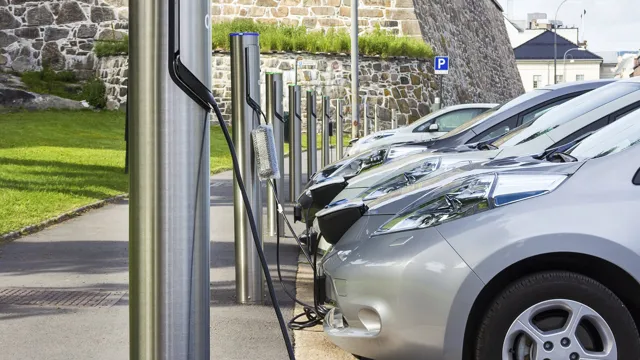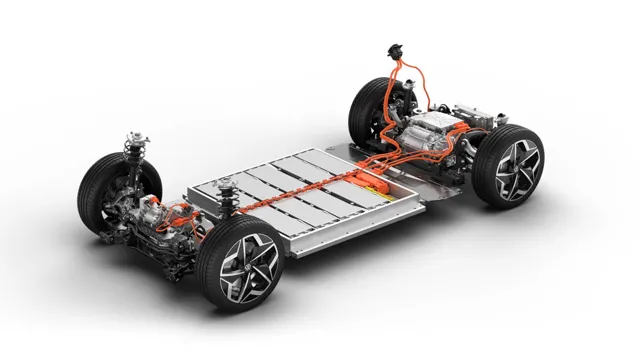Revolutionizing the Road: Power Up Your Electric Car Battery While You Drive
Imagine being able to charge your electric vehicle as you’re driving down the road. It may seem like something out of a sci-fi movie, but this technology is closer than you might think. Wireless charging technology has been in development for some time now, and as electric vehicles become more common, the need for more efficient and convenient charging options is becoming increasingly important.
Charging your EV while you drive not only eliminates the need for frequent stops for charging, but it could also extend the vehicle’s range and reduce the need for a large battery size. This blog will explore the potential benefits and challenges of charging your EV while you’re on the go and what the future of wireless charging technology might hold.
Benefits of Charging on the Go
Charging electric car batteries while driving has numerous benefits that both car owners and the environment can enjoy. Firstly, it can increase the driving range of electric vehicles, keeping them on the road for longer periods without the need for pit stops. This is especially beneficial for long distance travels, eliminating range anxiety and the need to constantly search for charging stations.
Additionally, it reduces the need for accessing public charging stations, saving valuable time and money. Secondly, charging on the go is environmentally friendly, as it promotes the use of renewable energy sources such as solar power. The integration of solar panels into car roofs or windscreens can also help recharge the battery while driving, making the whole process even more efficient.
Overall, charging electric car batteries while driving is a smart solution that enhances convenience, saves costs, and promotes a sustainable future.
Increased Range and Reduced Charging Time
Charging on the go can bring a range of benefits, including increased range and reduced charging time. Whether you’re planning a long road trip or just need to top up your battery on a busy day, stopping to charge can be a smart move. With the ability to plug in at a public charging station or use a portable charging device, you can extend your electric vehicle’s range and reduce the amount of time it takes to charge up.
Plus, the convenience of charging on the go means you can keep up with your busy lifestyle without worrying about running out of juice. So next time you’re on the road, consider the benefits of charging on the go and take advantage of the latest technology to enhance your electric driving experience.

Cost Savings on Energy Bills
Charging on the go not only benefits our ever-busy lifestyle, but it can also lead to cost savings on energy bills. With the increasing popularity of electric vehicles, charging stations are popping up everywhere, from public parking lots to highway rest areas. By taking advantage of these charging stations, drivers can reduce their reliance on at-home charging, which not only saves electricity but also helps to lower demand during peak hours.
This means that during times of high energy usage, such as in the evenings when people return home from work and school, charging your EV on the go can help to mitigate overall energy costs. Furthermore, using public charging stations can also help to reduce the need to invest in a home charging system, which can be quite expensive. Saving money on energy bills while helping to reduce strain on the electricity grid makes charging on the go a win-win for both drivers and the environment.
So next time you hit the road in your EV, consider taking a pit stop to charge up and save some energy dollars in the process.
How Charging While Driving Works
Charging an electric car battery while driving is a relatively new concept that has been gaining popularity in recent years. The idea behind it is to generate electricity while the car is moving, which can help extend its driving range. This is usually done by using technologies like inductive charging or regenerative braking, where the process of braking generates energy that can then be used to recharge the battery.
However, it’s worth noting that this method of charging is still in its early stages of development and isn’t widely available yet. While it may seem like a great way to combat range anxiety, it’s important to remember that it’s not a solution that’s suitable for everyone’s needs and driving habits. Nonetheless, electric car manufacturers and charging station companies are actively working to improve this technology and make charging while driving more accessible and efficient.
Regenerative Braking Technology
Regenerative braking technology is a highly innovative concept in the automotive industry that has revolutionized the way we think about energy efficiency and sustainability. One of the most intriguing features of this technology is the ability of electric and hybrid vehicles to charge while driving using their own energy-producing systems. Essentially, regenerative braking systems work by converting the kinetic energy generated during braking into electrical energy that is then used to recharge the vehicle’s battery.
This means that the more braking the car does, the more energy it generates, and the longer the battery life. It’s like a self-charging battery that never needs to be manually recharged. Imagine never having to worry about finding a charging station ever again.
That’s the power of regenerative braking technology.
Solar Panels on the Roof
Solar panels on the roof are an excellent way to save money on fuel and reduce your carbon footprint. However, what about charging your electric car while driving? Well, this is an idea that has been tested and implemented by many car companies, and the concept works in several ways. Firstly, some cars out there have built-in solar panels on the roof that can be utilized to power the vehicle while driving.
These panels charge the battery via a device called a “charge controller” that regulates the charging process. Secondly, there are solar charging stations available where solar panels capture the energy from the sun and then store it to charge your car’s battery while you park and enjoy your activities. Now, it’s important to note that this isn’t a brand-new idea, as solar vehicles were first introduced in the 1980s.
But what is more exciting is the innovation that is happening in this industry. In conclusion, charging your electric car while driving is on the rise, with car manufacturers and solar energy companies working to make this technology more accessible and affordable. The keyword for this blog section is “Solar Panels on the Roof.
“
Inductive Charging Pads on the Road
Inductive charging pads on the road allow for convenient charging of electric vehicles while driving. This technology leverages wireless charging, similar to how we charge our phones wirelessly. Essentially, charging pads are installed underneath the road surface and equipped with magnetic fields that produce an electric current in the vehicle’s battery through induction.
This allows drivers to charge their vehicles without the need to stop and plug in at a charging station. While this technology is still in its early stages, it has the potential to revolutionize the way we charge electric vehicles and make it more accessible for longer trips. The future of driving may involve a seamless experience where drivers no longer need to worry about running out of battery power on the road.
EV Models That Support Charging While Driving
One of the most common concerns that electric vehicle (EV) owners have is the range anxiety of running out of a charge while on the road. However, there is a solution to this issue: charging the car battery while driving. Some EV models have the capability to charge while driving, which can alleviate the anxiety of running out of power.
Essentially, these vehicles are designed with an inductive charging pad that is located under the car and connects to an inductive pad on the road. This connection enables the transfer of energy from the road to the car battery while driving. Although this feature is not currently available in all EV models, several manufacturers have announced plans to introduce it in the near future.
By charging the battery while on the road, EV owners can enjoy a sustainable and comfortable driving experience without worrying about running out of power.
Tesla Model S and Model X
Tesla has been at the forefront of electric vehicle (EV) innovation for years. Both the Model S and Model X from Tesla offer a unique and exciting feature that is not found in other EV models, the ability to charge while driving. This feature allows drivers to travel longer distances without the need for frequent stops to recharge.
The Model S and Model X offer high-tech capabilities that make it possible to charge the battery while in motion, creating a more efficient and convenient driving experience. With this innovative feature, Tesla is making driving an electric vehicle more practical and appealing to the masses. In summary, EV models that support charging while driving, like the Tesla Model S and Model X, are changing the game for electric vehicle travel and making it easier for drivers to make the switch from traditional gasoline-powered cars.
BMW i3
When it comes to choosing an electric vehicle (EV), it’s important to know which models support charging while driving to optimize your driving experience. One model that stands out is the BMW i This sleek and stylish EV offers a range of up to 153 miles on a single charge, making it perfect for daily commutes or weekend road trips.
But what makes the BMW i3 a standout is its ability to support both DC fast charging and AC Level 2 charging, allowing you to charge while on the go. With its innovative technology, you can easily monitor your battery capacity and charging status from your smartphone. Plus, the BMW i3’s eDrive system provides instant torque and smooth acceleration, delivering the ultimate driving experience.
If you’re looking for an EV that supports charging while driving, the BMW i3 is definitely worth considering.
Challenges and Limitations
One of the most exciting prospects in the world of electric vehicles is the possibility of charging your car’s battery while you’re driving. While the technology to make this a reality is still in development, there are a number of challenges and limitations that researchers will need to overcome before we can hit the open road with our electric cars running on self-contained power. One major issue is the amount of energy required to charge a battery on the go.
Current battery technology is capable of handling relatively small charges from regenerative braking, but a full charge on the go would require a much higher voltage and amperage. Another limitation is the infrastructure required to support this kind of charging. It’s likely that a network of charging stations would need to be developed, which would require a significant investment of resources from both private companies and governments.
Despite these challenges, the benefits of charging your electric car while you drive are too great to ignore, and it’s exciting to think about the future possibilities that this technology could bring.
Safety Concerns and Regulations
The drone industry has experienced significant growth in recent years, leading to concerns about safety and regulations. One of the major challenges facing the industry is the need to ensure the safe operation of drones. As drones become more popular, it is essential to establish clear guidelines for their use to minimize the risk of accidents and injury.
Another limitation is the issue of privacy. With drones capable of capturing high-quality images and videos, there is a risk of individuals’ privacy being invaded, leading to concerns about surveillance and intrusions. Moreover, there are also concerns about the potential misuse of drone technology, such as weaponization.
It is essential to establish strict regulations to prevent such actions and to ensure drones are used safely and responsibly. Overall, while the drone industry presents many opportunities, it also requires careful consideration and careful management to address the challenges and limitations effectively.
Limited Availability of Charging Infrastructure
One of the major challenges faced by the electric vehicle industry is the limited availability of charging infrastructure. While it’s true that electric vehicles require less maintenance and fuel costs are lower, drivers are still in need of reliable charging stations. In more rural areas, this can be especially problematic, as there may be no charging stations available for miles.
Even in urban centers, charging infrastructure is often insufficient, leading to long wait times or the inability to find a charging station at all. This situation can be frustrating for drivers who are looking to transition to electric vehicles, but it’s also a significant hurdle for car manufacturers trying to attract new customers. Without a reliable, widespread charging infrastructure, electric vehicles may remain a niche market for some time.
Impact on Battery Life and Performance
One of the biggest challenges faced by mobile devices is the impact that various apps can have on battery life and performance. When apps use too much processing power or constantly run in the background, they can drain the battery and slow down overall device performance. This can be particularly frustrating for users who rely heavily on their devices to stay connected and productive throughout the day.
However, developers must also balance the need for high-performance apps with the limitations of mobile devices, including limited processing power, memory, and battery life. While there are various techniques and tools available to optimize app performance, these capabilities are often limited by the hardware and software limitations of mobile devices. As a result, developers must carefully consider the impact of their apps on battery life and performance to ensure a positive user experience.
Conclusion
In a world moving towards sustainable and environmentally friendly transportation options, the idea of charging electric car batteries while driving seems like a no-brainer. However, as with any innovative technology, there are still kinks to be worked out. While the concept of harnessing kinetic energy to charge a car’s battery is exciting, it remains to be seen if it will become a viable and widespread option for drivers.
For now, we’ll stick to plugging in and singing along to our favorite tunes on road trips. Stay charged, my friends!”
FAQs
Can you charge an electric car battery while driving?
Yes, it is possible to charge an electric car battery while driving using regenerative braking technology.
How does regenerative braking technology work?
Regenerative braking technology works by using the electric motor of the car to slow down the vehicle, which produces electricity that is stored in the battery.
Can a car with a low battery charge while driving?
Yes, a car with a low battery can charge while driving through regenerative braking and also by using special charging systems on the road.
Is it safe to charge an electric car battery while driving?
Yes, it is safe to charge an electric car battery while driving as long as safety protocols are followed, and the charging process is done through regenerative braking or using the appropriate charging system.






